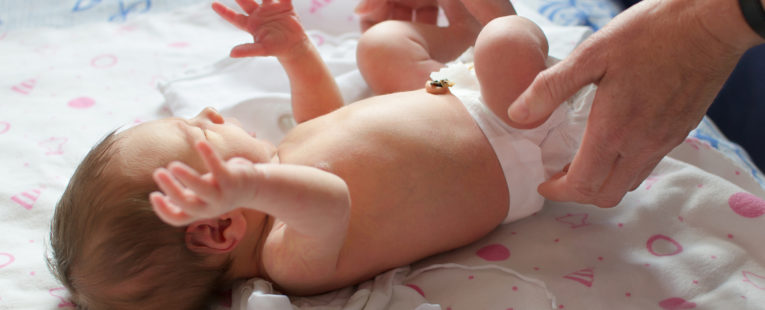The umbilical cord connects your baby’s body to your body. When your baby is growing inside of you, they rely entirely on you. Your baby’s umbilical cord gives them everything they need to grow and develop – including nutrients, oxygen and blood.
“The umbilical cord develops from the placenta, which is attached to the inside of your uterus,” Dr. Garcia said.
And even though it’s attached to you, you and your baby don’t feel the umbilical cord.
“Do we feel our uterus or any organ inside of us? Not really. It’s just there. That’s how the umbilical cord is,” Dr. Garcia said.
Cutting the umbilical cord
When your baby is finally born, the umbilical cord is still attached to your placenta. After birth, the umbilical cord is cut – sometimes by your support person and sometimes by one of the providers in the room. After it’s cut, a small stump is left. When the stump falls off a couple of weeks after birth, what’s left is your newborn’s belly button.
Babies don’t feel pain when the umbilical cord is cut. If your baby is crying after birth when the umbilical cord is cut, it’s likely because they are no longer in the warm, cozy environment they got used to in your belly.
“Moms don’t feel pain when the umbilical cord is cut, either,” Dr. Garcia said. “The umbilical cord technically belongs to our bodies, but at the same time, it doesn’t. It has no nerve endings.”
The cord is just a temporary line that connects mom and baby before birth. Once your baby is born and the placenta is delivered, the umbilical cord isn’t part of either body anymore.
Your provider care team will suture your baby’s umbilical stump. The providers will only stitch through the stump and not on your baby’s skin. Because it has no nerve endings, the baby can’t feel anything when they’re getting stitches.
Delayed cord clamping
Delayed cord clamping is when the umbilical cord isn’t cut right after birth. In general, early clamping is cutting the cord within 60 seconds of birth. However, the World Health Organization recommends delaying clamping the cord after the first minute and up to five minutes after birth.
“It’s one last push to give your baby all the rest of the blood flowing in the cord,” Dr. Garcia said.
It can especially help babies who are more likely to have low iron, and it can even benefit babies for a full six months after birth.
If you have specific hopes for cutting the umbilical cord – from who cuts the cord to delaying cord clamping – be sure to discuss them with your care team before delivery.
Umbilical cord concerns?
Umbilical cord care
When does the umbilical cord fall off?
“It should take no more than three weeks to fall off. Usually, the umbilical cord stump falls off on about day 10 of your baby’s life,” Dr. Garcia said.
“If your baby’s stump hasn’t fallen off in one month, call your doctor about your baby’s umbilical cord.”
Cleaning your baby’s umbilical cord
When you think about cleaning your newborn’s belly button, you don’t need to worry too much. That’s because it’s not necessary to give your baby a bath while they have the umbilical cord stump.
“Babies don’t need as many baths as we think they do. They don’t do much in the first few weeks of life that make them dirty,” Dr. Garcia said.
“Usually, babies get their first bath at the hospital, and it’s not you as the parents that need to do it, so there’s already less to worry about.”
Dr. Garcia recommends two things: Keep the stump dry and don’t touch it.
Do a sponge bath and keep the stump dry. So, when you do give your baby a sponge bath, don’t wash the stump.
“Doctors used to recommend cleaning the stump with alcohol, but that’s not recommended anymore. That only kills the bacteria that is needed to help the stump fall off. Plus, it may irritate your baby’s skin,” Dr. Garcia said.
Umbilical cord problems
Umbilical cord bleeding
Dr. Garcia said some baby belly button bleeding is nothing to worry about, but there are times when umbilical cord bleeding is a concern.
“It’s good to know what kind of umbilical cord bleeding you see. Active, persistent, bright red bleeding shouldn’t be happening. If it’s gushing, active bleeding, go to the emergency department. If it’s just a little bit of blood, you can talk to your baby’s pediatrician. Watery discharge or a little moisture from the stump after birth is OK.”
Normal vs. infected umbilical cord
A normal umbilical cord stump starts out yellow and turns brown or black.
An infected umbilical cord stump may smell bad, cause your baby to have a fever, cause redness around the belly button or cause unusual bleeding.
If it seems like it’s infected, you should call the doctor about your baby’s umbilical cord.
